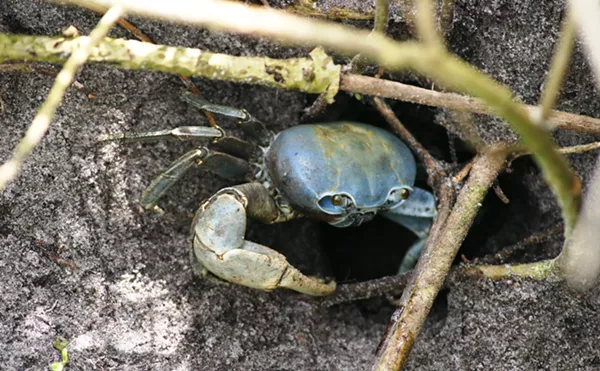Recently, officials have been considering whether the act of trainers riding Lolita the orca at the Miami Seaquarium should be considered harassment under the Endangered Species Act. Meanwhile, activists are arguing that such behavior poses a significant risk to the safety of the marine park's employees.
In July 2014, the Occupational Safety and Health Administration (OSHA), a division of the U.S. Department of Labor, stated that when it inspected the Miami Seaquarium, it found that "several animal trainers" were interacting in the water with Lolita.
These interactions, the government agency declared, were a hazard to the animal workers' safety because the trainers could be struck by the killer whale and harmed or even drowned by her.
OSHA's concerns are not unfounded. In 2010, Tilikum, a six-ton orca at SeaWorld Orlando, grabbed hold of renowned marine mammal trainer Dawn Brancheau and drowned her in the depths of the tank.
Her death shocked her colleagues. SeaWorld's workers had never anticipated that one of its killer whales would kill a trainer. To add to the confusion, in an internal review SeaWorld found Brancheau, who had worked with the animals for more than a decade, had followed all the company's safety protocols.
"There had never been a trainer fatality at SeaWorld prior to Dawn’s death," Fred Jacobs, SeaWorld's vice president of corporate communications, told New Times. "Prior to that, in-water interaction occurred hundreds of times a day every day for decades."
However, animal activists believe the attacks can be explained. Activists claim the aggression toward trainers is due to the tension killer whales endure by living in tanks and coming in close constant contact with people, because attacks on humans are nearly nonexistent in the wild.
Though some captive orcas have been in captivity for nearly 50 years, activists argue they retain their natural inclinations, such as swimming vast distances (up to 100 miles per day), and become agitated by their inability to engage in normal behaviors.
"Captivity is driving these animals insane," said Wendy King, who became passionate about captive orcas after watching the film Blackfish. "It's extremely depressing and stressful for orcas, and that is what makes them become aggressive and attack. We've seen four people killed by orcas in captivity, three of them trainers. Orcas are intelligent and social animals. Gentle too, until you start keeping them in these unnatural settings and subjecting them to stress..."
After Brancheau's death, trainers still interacted with the killer whales in the water, which led OSHA to cite SeaWorld and government officials stating that the marine park "recognized the inherent risk of allowing trainers to interact with potentially dangerous animals, [yet] Nonetheless... required its employees to work within the pool walls, on ledges, and on shelves where they were subject to dangerous behavior by the animals."
The citation led to litigation, and in April 2014, the D.C. Circuit Court of Appeals upheld OSHA's enforcement of worker safety laws against SeaWorld in account of Brancheau's death. Animal advocacy groups believe Brancheau's death could have been prevented by earlier enforcement from OSHA. In response to the court's decision and the concerns from the government agency for the safety of the workers, SeaWorld then pulled its trainers from performing in the water with the orcas.
"Stopping in-water interaction during shows was part of a complete review of our killer whale program that followed Dawn Brancheau's death," Jacobs said.
He especially cautioned that humans should not interact with killer whales in the wild because as apex predators, they are more than capable of killing a smorgasbord of animals. Indeed, they are even capable of turning great whites into fish confetti.
It has been five years since SeaWorld trainers have been allowed to perform with killer whales in the water, and according to Jacobs, the "only" in-water interaction with the massive marine mammals that still occurs is safety desensitization training.
Though the Orlando-based company pulled trainers from the water for shows, the Miami Seaquarium still allows its trainers to swim in the water and perform with Lolita. The Animal Legal Defense Fund alerted OSHA of this, which resulted in the government agency's inspection and 2014 declaration that it was hazardous to trainers' safety, issuing the Seaquarium a $7,000 fine.
See also: Miami Seaquarium Fined $7,000 for Letting Trainers Work With Lolita Unprotected
"The Seaquarium is absolutely putting trainers' lives at stake," said Matt Liebman, an attorney at the California-based law firm. "We've complained to OSHA, which has fined the Seaquarium for its reckless behavior."
The Miami Seaquarium disagreed with the government agency's finding, and on August 25, the park's attorneys are expected to argue before an administrative law judge for OSHA why Lolita, in particular, does not present a threat to trainers.
However, instead of preventing trainers from performing with Lolita until an official decision is reached, trainers at the park still ride the 7,000-pound killer whale like a surfboard.
This has left animal advocates confused as to why the Seaquarium would still allow this practice despite the government agency declaring it hazardous to trainer safety (the spectacle makes for a better show for audiences), especially since Lolita has been known to be "moody."
While in captivity, she has had a history of lunging at trainers on the island platform at the center of her enclosure and even tearing off at least one trainer's wetsuit. There have also been times that shows were impossible to conduct because her aggressive behavior frightened trainers.
Recently the nearly 50-year-old killer whale has snapped at park guests, suggesting Lolita may be agitated by her surroundings.
"All Seaquarium/SeaWorld trainers and owners are on the wrong side of history — they are all engaged in a cruel circus show, a spectacle of dominance that is morally reprehensible that should and will be banned in the very near future," Louie Psihoyos, director of the Academy Award-winning documentary The Cove, told New Times. "A growing population looks at this sad chapter in our dysfunctional relationship with nature as an abomination. Florida abusement enterprises like SeaWorld and the Seaquarium should... return these animals to the wild, where they can (if successfully rehabilitated) or to a sea pen to live out their lives without having to do circus shows..."
Activists say the fact Lolita lives in the smallest killer whale tank in North America and is deprived from the social stimulation of other orcas may make her especially vulnerable to mental frustration. They say trainers should stay out of the way for their own safety because harassing her by physically mounting her, especially when she is moody, is "definitely' hazardous.
"The safety of trainers should be Miami Seaquarium's top priority. No show is worth risking a life," said King. "And that's what they are doing with every performance. If [Lolita] continues to live in these terrible conditions, I have no doubt she could lash out in violence, because there is always a breaking point. It's just a matter of time until something happens..."
New Times has reached out the Miami Seaquarium regarding its practice of allowing trainers to ride Lolita, however, the park has not responded.
Osha Citation and Letter by ALDF












